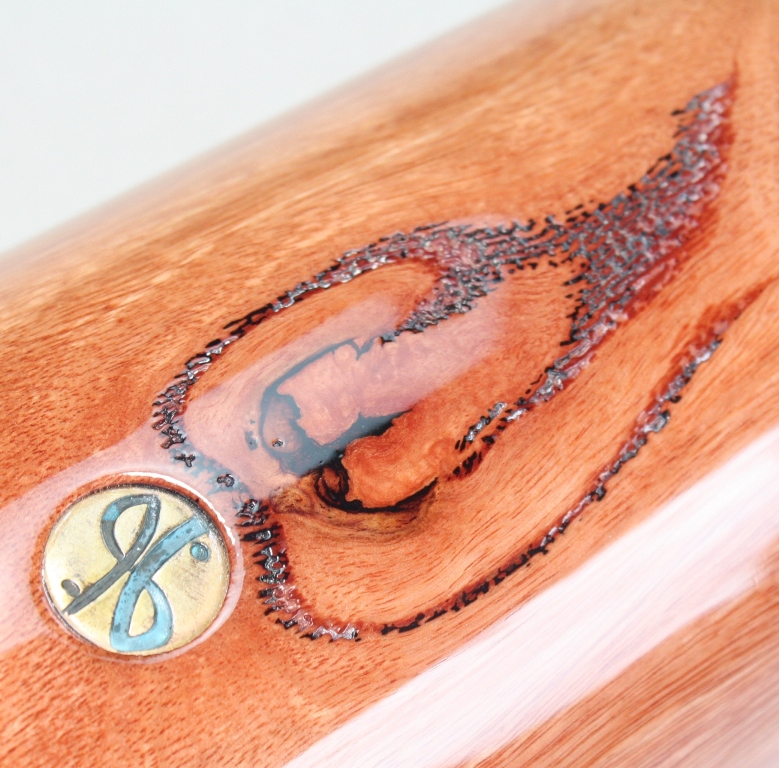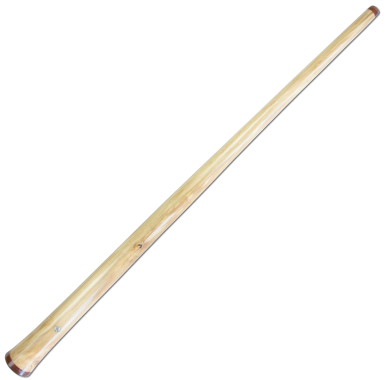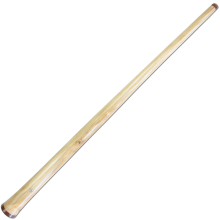Duende Kairos
Duende Classe Argent (Apprenti)
Comments from Dubravko Lapaine: The primary idea behind this didgeridoo was to create an instrument that would allow the playing of as many different styles and techniques as possible. It features a comfortable backpressure that allows for easy learning of breathing, as well as advanced levels of breathing. The Kairos model allows for very easy execution of the toots, which is excellent for learning to play them separately, but also during play and with the melody. Next, very importantly, Kairos is designed in such a way that it is good for traditional playing techniques, where, of course, all the tongue movements are well expressed. It has a very solid aircode. And yes, you can play it acoustically because it has a fairly loud volume, and you can play it in the streets, you can play drones, and you can play harmonics. But the main idea behind Kairos is not so much to specialize in a certain aspect, but to draw attention to the different playing styles that are easily achieved through this didgeridoo.
My comments: This type of didgeridoo is made of a single piece, pierced on both sides. Here is his Kairos class which, as its name suggests, is a class called 'for apprentices'. I am not necessarily a fan of this term because for me it is not just a class for apprentices, however the literal English translation gives this term. As you will have understood, Dubravko wanted to make an affordable didgeridoo but with the acoustic qualities of a high-class instrument, with the aim of giving accessibility to as many people as possible to a quality instrument.
- Duende Kairos: Silver Class (Apprentice) in hornbeam with ironbark trims
- Shipping costs are free! (only for France)
- Didgeridoo Passion also offers you the carrying case
Classification
This scale is the result of an air column/bell start ratio If we divide the diameter of the bell with that of the beginning of the air column we get a number between 1.5 and 3.5. We can classify all the didgeridoos in 4 large families. Each family groups the instruments with a similar character, simply based on the overall shape of the air column (conical/cylindrical) and on the diameter of the column (wide/narrow). The result is a simple and very reliable reading grid, making it easier to search and purchase on line.
The diameters are measured with a caliper, start of the air column after the mouthpîece. This ratio is very reliable for a didg having a air column with a 'smooth' internal work, in the case of a hollowed eucalyptus instrument it give an approach of the instrumental character.

Duende
Dubravko Lapaine & Danka Tišljar, Manufacturers of "Duende" didgeridoos
Here's something I've never done until now, but to open the subject: For comparison, we can compare the world of didgeridoo manufacturers to the world of automobiles. By this I mean that in the case of a car, we find all kinds of brands, finishes, power for ultimately the same goal of transporting us from point A to point B. However, you are all d I agree that comfort is not the same in a two-horse car or in a Ferrari... Well the didgeridoo is the same thing, the purpose is the same: to be able to transcribe a vibration. To date, after 20 years of playing, hundreds of didgeridoos tested and meeting many manufacturers, I can give you my perspective. If I had to place one type of didgeridoo in place of the Ferrari it would be the Duende didgeridoos by Dubravko Lapaine. To fully understand the characteristics of a didgeridoo and therefore be a good maker, you must first of all be a good player.
 You see what I mean. Dubravko is recognized as the best technician in the world. he has such high standards for himself that it shows in his production. Why do I think Duendes are the best didgeridoos you can find? It can't be summed up in a single sentence, but it starts with the drilling manufacturing process that Dubravko has mastered to perfection. No cutting or gluing for ultimately better control of dimensions. Imagine drilling straight over a length of more than 2 m... This continues with the type of wood used. This time again Dubravko leaves nothing to chance, he uses the densest wood species we can find. This aims to contain vibration as much as possible and provide a wealth of harmonics and exceptional playability. But this has a downside... the sharpening of the tools which you have to do constantly and therefore an enormous amount of work time... We continue with the internal configurations of the air columns. Again Dubrako has developed these own configurations over the years and his concerts. Because above all he makes his own instruments seeking a compromise between the finesse of sounds and technicality. In the execution of all game techniques and sounds.
You see what I mean. Dubravko is recognized as the best technician in the world. he has such high standards for himself that it shows in his production. Why do I think Duendes are the best didgeridoos you can find? It can't be summed up in a single sentence, but it starts with the drilling manufacturing process that Dubravko has mastered to perfection. No cutting or gluing for ultimately better control of dimensions. Imagine drilling straight over a length of more than 2 m... This continues with the type of wood used. This time again Dubravko leaves nothing to chance, he uses the densest wood species we can find. This aims to contain vibration as much as possible and provide a wealth of harmonics and exceptional playability. But this has a downside... the sharpening of the tools which you have to do constantly and therefore an enormous amount of work time... We continue with the internal configurations of the air columns. Again Dubrako has developed these own configurations over the years and his concerts. Because above all he makes his own instruments seeking a compromise between the finesse of sounds and technicality. In the execution of all game techniques and sounds.
We now move on to finishing the instruments, both inside and out. Because a beautiful paint job on a car immediately has an effect, the same goes for the didgeridoo. By this I mean that each Duende is truly unique. These are real collector's items. If you have ever held a Duende in your hands you will understand what I am telling you. Inlay, engraving, pyrography and so on, all these techniques add enormous added value and bring the instrument to life. I hope that through these words you will understand the value of Duende didgeridoos. So yes the Duendes are not cheap but I think that after what I have just written it allows you to understand the extreme value of its instruments. Just like a Ferrari, it is a treasure that we offer ourselves for the ultimate passion. Unique know-how, for a unique design, playability and finish!

